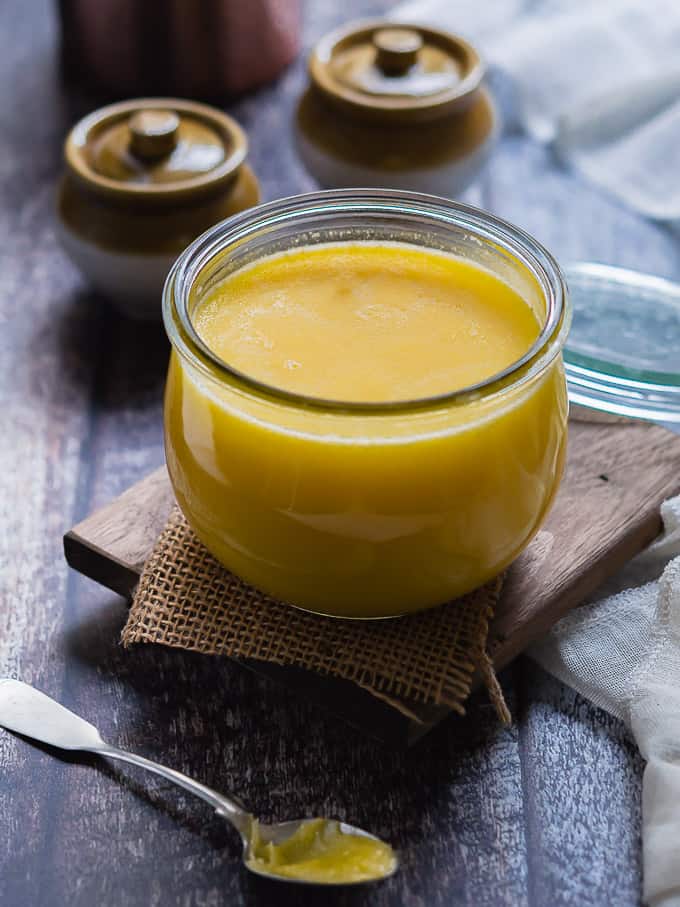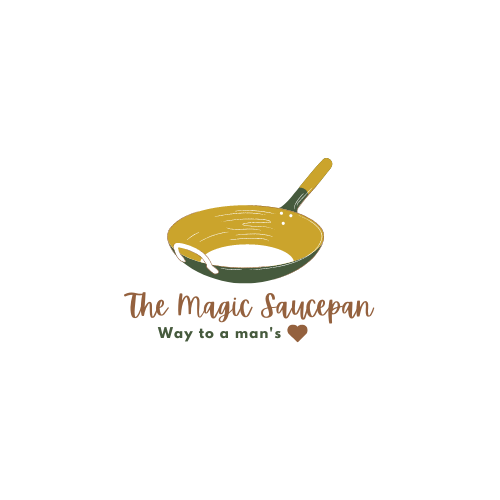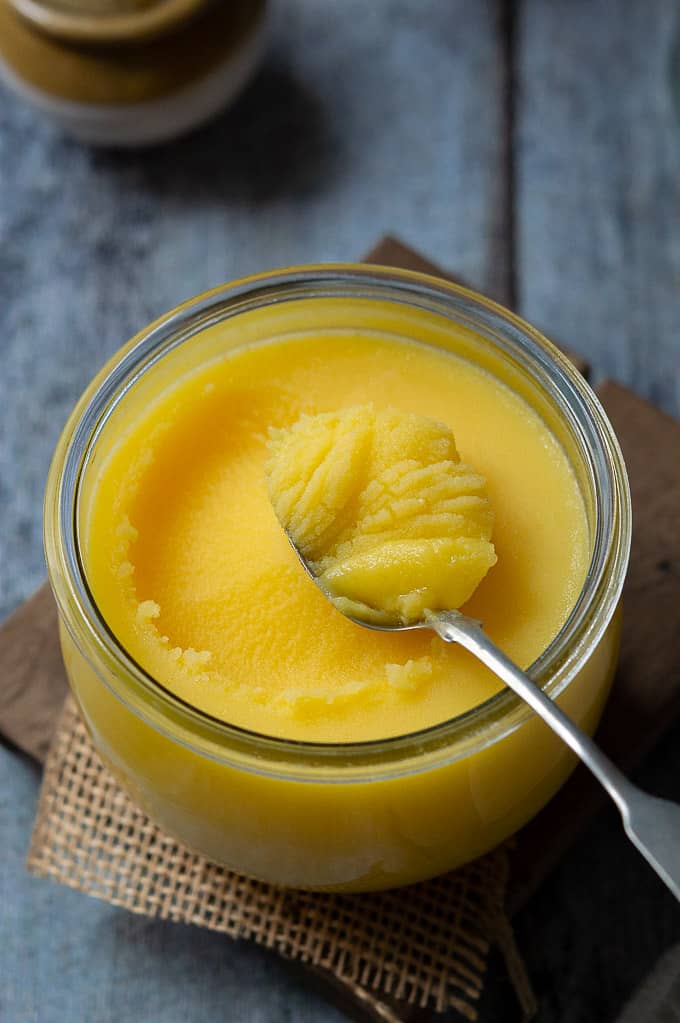Ghee, the Indian clarified butter, is an aromatic and healthy flavouring fat used in Indian cooking - sautéing, stir frying or deep frying. Contrary to the popular belief its so easy to make it at home. Read more to find out how to make ghee at home and also how culturally important ghee is in the Indian scenario.
Since time immemorial, dairy products are revered and extolled by Indians. It is intertwined in our lifestyle. Milk and Ghee being the top in hierarchy.
Ghee, the ancient super food, originated in India. Contrary to the discovery of butter, ghee was a well thought out invention to overcome the of lack of refrigeration in the olden times. Butter quickly becomes rancid at room temperature whereas ghee is shelf stable and thereby facilitates portability.
The term ghee is derived from sanskrit ghrita ( the root word ghr means to brighten up / shine ) in to hindi ghi and phonetically ghee. It is known as nei in Tamil. Nei refers to any semisolid or liquid fat.

So, What is Ghee ?
Ghee is a type of clarified butter where milk solids and liquid fats are separated by heating. It is a predominate cooking fat in the Indian cooking. Indians call this the "Desi Ghee". Desi, refers to anything that is made in India!
The Desi Ghee
Ghee, in India, is a sacred fat and is considered pure. Quoting K.T. Acharya, from The story of our foods, the Aryans looked down upon any other cooking oils and insisted that everything should be fried in pure ghee.
Prasad, food offerings to God during religious occasions, are only made with ghee. People fast during these auspicious days and they can intake only certain kinds of food. According to Vedic cooking practices, food is divided into pucca khaana - one that is purified by completely cooking in ghee, and kaccha khaana, one that is not. According to his writings, it doesn't end there. They also followed an order in which ghee is added to the food which will determine if it is a pucca khaana or not. Hence ghee cooked food is preferred during fasting days.
Well, I am not going to delve deep into these practices. Needless to say that ghee is a highly regarded cultural entity in the Indian set up. It is the holy ingredient of India.
Since ghee is held in high regards, it has its significance more than in the food scenario. During any Hindu religious occasions, ghee is used to maintain the sacred fire. People light diyas (the indian earthen lamps) with ghee at home. It is believed that it is the purest form and one of the important offering to the fire god.
Ghee is also associated with folk tales and mythology in the Indian culture.
In the legendary epic, Mahabartha, it is said that the Kauravas (100 siblings) were born out of 100 individual pots of ghee.
Ghee Benefits & Nutrition
Ghee, the liquid gold of India, has always been in a controversial debate regarding its calories and benefits until recent years. When I was little, for the first one year, all my mom gave was dal and ghee rice. We never has a meal without ghee on the table and I am sure that was common in most Indian homes. Then, somehow Ghee was vilified and even Indians ignored it. But again in the last couple of years things are starting to turn around and now there is no article in the internet without praising the glory of Ghee.
- According to Ayurveda, Ghee is rejuvenating and is considered a natural ailment for balancing heat in the body.
- It is one of the easily digestible fats.
- It is important for our immunity as it helps in absorbing fat soluble nutrients like Vit D, A, E & K.
Above all, its delicious, tasty and when taken in moderation it is perfectly healthy!
How to make Homemade Ghee
The traditional way of making ghee is churning cream got from milk into butter and then turning the butter into ghee. Thats the ancient and Ayurvedic way of making ghee. But the easiest and common way is making ghee with unsalted butter.
Ghee vs Clarified butter
Though ghee is commonly known as clarified butter, ghee and clarified butter are slightly different. Ghee is cooked a bit longer, milk solids are browned and it has more shelf life than clarified butter.
Frying in Ghee
Ghee is used in deep frying Indian food items since ancient times. One of the main advantage of ghee over butter is its smoking point. Removing the milk solids and water molecules from butter gives ghee a high smoking point and makes it a perfect candidate for deep frying. South Indian snacks like Athirasam, Appam, poori were all traditionally deep fried in Ghee.
Recipes with Homemade ghee
This is not an exhaustive list.
- Tadka, the Indian tempering technique uses ghee in most instances.
- Ghee rice Nei choru - A simple rice made with ghee and minimal spices.
- Jeera Rice - Rice variety made with cumin seeds and black pepper.
- Ven Pongal - The Indian savoury porridge variety. Mostly a brunch staple made with rice and lentils and ladled with ghee. 🙂
- Rava Pongal - Similar to ven pongal where rice grains are substituted with semolina.
- Khichdi - Another rice and lentils based dish which is a North Indian staple.
- Roti / Paratha
- Sakkarai Pongal
- Akkaravadisal
- Payasam / Kheer
- Rava ladoo
- Maladoo
Tips to make a perfect textured homemade ghee
- Always use a good quality butter. The quantity and quality of ghee depends on the butter you use. So is the texture and colour. The Desi ghee made made from the cream of milk is almost white in colour.
- Make ghee on a medium flame and keep stirring it frequently. Else the milk solids will burn easily giving the ghee a burnt smell.
- Adding Moringa leaves at the end of the process gives it a wonderful aroma. You can also add curry leaves.

Homemade Ghee, the Indian clarified butter, is an aromatic and healthy flavouring fat used in Indian cooking - sautéing, stir frying or deep frying.
- 750 grams unsalted butter
-
Put the block(s) of butter in a heavy bottomed saucepan on medium heat.
-
Once it melts completely, a thick frothy layer will form on top. After about 3-4 minutes, it will start bubbling. Keep stirring now and then.

-
The forth will be thick and as it simmers, the thick frothy layer will separate into whey and float on top.
-
The bubbling will increase and the foam will become thinner. The layer under the foam starts becoming clear. Keep stirring it frequently.

-
After some more time, the frothy layer disappears, the mixture will become more clear and the milk solids will start sticking to the sides of the pan. While you are stirring also keep scrapping the sides of the pan.

-
After some more time, the milk solids will start settling at the bottom and bubbles will decrease. Keep stirring to avoid burning at the bottom.
Once the milk solids start browning and the clear melted butter will turns to a golden hue, ghee is ready. Now add the moringa leaves or curry leaves. It takes 25 minutes to get to this stage.

-
Turn off the flame and let it cool a bit. Then sieve it using a mesh strainer and transfer it to a clean and dry airtight container.
-
Use the strained milk solids to prepare ghee rice or wheat ladoos. It is edible with a slightly strong flavour. Try ways to use it.
-
As the ghee cools, it turns semi solid. If the outside temperature is cold or in winter time, it completely solidifies.
- Always use a good quality butter. The quantity and quality of ghee depends on the butter you use. So is the texture and colour. The Desi ghee made made from the cream of milk is almost white in colour.
- Make ghee on a medium low flame and keep stirring often. Else the milk solids will burn easily giving the ghee a burnt smell.
- Some people skim off the whey that floats on top in step 3. But, it is not necessary.
- Adding Moringa leaves at the end of the process gives it a wonderful aroma. You can also add curry leaves.
- Don't let ghee sit on the pan for a long time. It solidifies as it cools.
- Transfer it immediately and use a non-plastic mesh strainer to sieve the milk solids.
- You can use the milk solids to prepare ghee rice or wheat ladoos.







Desi Cow Ghee in Pune says
Desi Cow Ghee in healthy product...!!! and thank for info
Sasmita Sahoo Samanta says
Really, nothing can beat the fresh homemade ghee!! So nicely you have shared detailed instructions for anyone 🙂
Pavani says
Oh what a coincidence today only I prepared the ghee.I made the same way as you showed except I added salt. Thanks for the nice tip for How to use the leftover milk solids .
Jagruti Dhanecha says
Nothing beats homemade products, I absolutely love the wafting aroma of ghee while in the making.
Jayashree says
Nothing like home made ghee. I too make my own butter and ghee ! Nice share
Geetha Priyanka says
Homemade ghee is always best. Store bought ones never comes closer in terms of aroma and flavours. You have very well explained with process shots.
Lathiya says
I love homemade ghee too...I also make my own ghee ... your ghee looks perfect..love it
Freda says
Love the color and the texture of your homemade ghee. It sure is a hundred times better than commercially available ones. Wonderful post 🙂
Sujata Roy says
Loved your write up. Homemade ghee is always best. Never used store bought. I store the malai or milk topping in refrigerator. And churn it to make butter. Awesome click.
Mildly Indian says
I love this texture of ghee you have made. Mom used to add a few curry leaves or moringa leaves right about when it is time to take it off the heat and we used to get to munch on that crispy ghee-laden one soon after and spoons to lick. reminded me of those
Ruchi says
Nothing like fresh homemade ghee. It tastes and smells amazing. We also add some dry fenugreek seeds , some paan and a pinch of turmeric powder, it will preserve ghee for years without any bad smell. Beautiful pics.
Preethi says
Nothing like fresh homemade ghee!! I totally hate the store bought ones 🙂 Its nice that you shared detailed instructions for beginners 🙂
Vanitha Bhat says
Golden beauty!! This is a must in any Indian kitchen and now the world is learning it's tremendous benefits and flavor! Your post explains well how to make ghee at home with no bother! Thanks for sharing and such beautiful clicks!
Priya Suresh says
Golden beauty is definitely a must in my kitchen, homemade ghee is always welcome here. I dont forget to make them quite often. And your clicks are seriously tremendous Nisha.
Mayuri Patel says
Ghee definitely brightens up any dish, flavor wise and aroma wise. This golden semi liquid is truly like gold in the kitchen and yes much healthier than commercially prepared oils. Making ghee at assures us that its authentic and not adulterated.
Lata Lala says
Homemade ghee is what I always crave for. It's such an essential part of Indian cooking. A dollop of it atop paratha and I am sorted.
Yummilicious post.
amrita says
Amazing captures and homemade ghee is always the best...